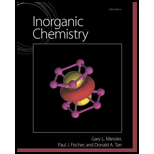
Concept explainers
Give Lewis dot structures and sketch the shapes of the following:
a.
b.
c.
d.
e.
f.
g.
h.
i.
Want to see the full answer?
Check out a sample textbook solution
Chapter 3 Solutions
Inorganic Chemistry
- Using the VSEPR model, determine the molecular shape about the central atom in BrF5. O a. trigonal pyramidal O b. square pyramidal O c. square planar O d. octahedral O e. tetrahedralarrow_forwardWhat is the electron- pair geometry of the central oxygen atom of O-Zone (O3) ? Abu U A. Linear B. Trigonal planner C. Tetrahedral D. Trigonal bipyramidal Land okarity isarrow_forwardWhich of the following molecules is non-polar? KCI O A. NaCl В. Al P C. OD. F2 CaO E.arrow_forward
- 5. Which of the following covalent bonds is the LEAST polar? а. С - CI d. N-F е. О -Н f. 0-S b. С-Н С. Н-СI 6. Which of the following is the electron configuration of oxide, O?. a. 1s°2s°2p* b. 1s°2s°2p° c. 1s°2s°2p® d. 1s°2s°2p®3s?3p* e. 1s°2s°2p°3s°3p° f. 1s°2s°2p®3s°3p®arrow_forwardDraw the Lewis structures of the following compounds: A. CC22F2 В. О2 C. PF3 D. SO3-2 Ε. ΗNO3arrow_forward17. According to Lewis Octet Theory, the ZH-N-H bond angle in the NH4* cation is...? А. 180° В. 120° С. 109.5° D. 90° E. Not enough information to tell 18. Which of the following ions has the largest atomic size? A. S2- В. СF C. Ca2+ D. K* E. All of the ions above are the same size 19. Which of the following molecules has the widest (largest) ZO-Y-O bond angle? Y represents the central atom in each. A. H2SO4 В. НЗВОЗ С. Si(OH)4 D. HЗPO4 E. The 20-Y-O bond angles are the same in each of the molecules above. 20.Consider the following series of elements. In which series does the ionization energy of the atoms decrease? А. О, N, C В. N, O, C С. N, C, O D. C, O, N Е. С, N, Oarrow_forward
- ANS 152 252 2P 12. What is the chemical formula of the compound formed by Barium ion and sulfate ion2ANS E ANS A 13. Write chemical symbols for the following ions: a. Sulfate ion Ans SO42- b. Sulfur ion ANS S-2 14. Write the Lewis Structure for N₂ 15. Write the Lewis Structure for SC1z (S is the center atom) 16. The bed in O₂ is a. Non- b. Polar covalent c. Ionic ited States) covalent ANS eer Services Accessibility: Unavailable Focusarrow_forward8. Consider the molecules C2H6, NCI3, NaF, and SiO2 aheq-n.cbiupil art to a. In which compound are the bonds most polar? bien no bescd eeonsla b. Which compound on the list has the most nonpolar bonds? Snollomto to ae0nol 1slugniomelni seopnota erit asrl beibuta elordools or to ro C. Which ones are most likely to exist as gases at 25 °C and 1 atm?arrow_forward5. Draw Lewis structures for the following: a. IC13 b. CO2 с. Оз d. H3PO4 e. SbF6 - f. InBr3arrow_forward
- Which of the following molecules has the shortest nitrogen-to-nitrogen bond: N2H4, N20, N2, N204? Select one: O a. N2 O b. N204 O c. N2H4 d. N20 Several resonance structures for the molecule CO2 are shown. Which one of them is likely to be of little importance in describing the bonding in this molecule? Select one: a. 0=C3D0 O b. 0 C-0: 2+ - c. T0-C-Oarrow_forwardWhich of the bonds in the image IS NOT allowed? H H но, 5 OH 'H. 4 6. O 7 1 2arrow_forwardThe bond length in an HI molecule is 1.61 A and the measured dipole moment is 0.44 D. What is the magnitude (in units of e) of the negative charge on I in HI? (1 debye = 3.34 x 1030 coulomb-meters; e=1.6 x 1019 coulombs) O 0.057 O 91 O 0.22 O 1.6arrow_forward
 ChemistryChemistryISBN:9781305957404Author:Steven S. Zumdahl, Susan A. Zumdahl, Donald J. DeCostePublisher:Cengage Learning
ChemistryChemistryISBN:9781305957404Author:Steven S. Zumdahl, Susan A. Zumdahl, Donald J. DeCostePublisher:Cengage Learning
 General Chemistry - Standalone book (MindTap Cour...ChemistryISBN:9781305580343Author:Steven D. Gammon, Ebbing, Darrell Ebbing, Steven D., Darrell; Gammon, Darrell Ebbing; Steven D. Gammon, Darrell D.; Gammon, Ebbing; Steven D. Gammon; DarrellPublisher:Cengage Learning
General Chemistry - Standalone book (MindTap Cour...ChemistryISBN:9781305580343Author:Steven D. Gammon, Ebbing, Darrell Ebbing, Steven D., Darrell; Gammon, Darrell Ebbing; Steven D. Gammon, Darrell D.; Gammon, Ebbing; Steven D. Gammon; DarrellPublisher:Cengage Learning Chemistry: The Molecular ScienceChemistryISBN:9781285199047Author:John W. Moore, Conrad L. StanitskiPublisher:Cengage Learning
Chemistry: The Molecular ScienceChemistryISBN:9781285199047Author:John W. Moore, Conrad L. StanitskiPublisher:Cengage Learning Chemistry: An Atoms First ApproachChemistryISBN:9781305079243Author:Steven S. Zumdahl, Susan A. ZumdahlPublisher:Cengage Learning
Chemistry: An Atoms First ApproachChemistryISBN:9781305079243Author:Steven S. Zumdahl, Susan A. ZumdahlPublisher:Cengage Learning Chemistry & Chemical ReactivityChemistryISBN:9781133949640Author:John C. Kotz, Paul M. Treichel, John Townsend, David TreichelPublisher:Cengage Learning
Chemistry & Chemical ReactivityChemistryISBN:9781133949640Author:John C. Kotz, Paul M. Treichel, John Townsend, David TreichelPublisher:Cengage Learning





